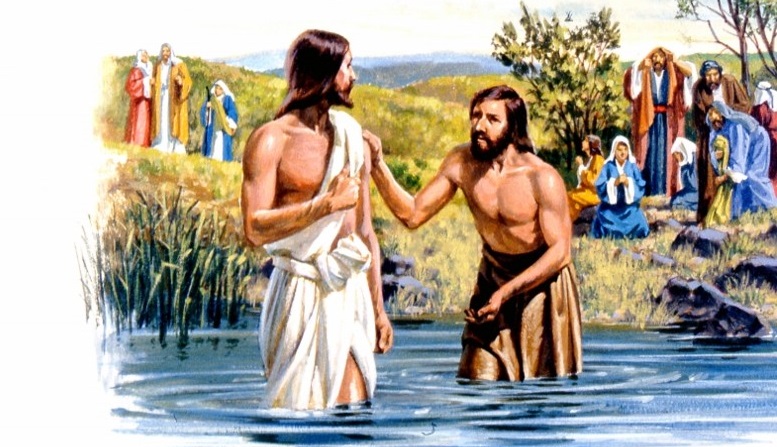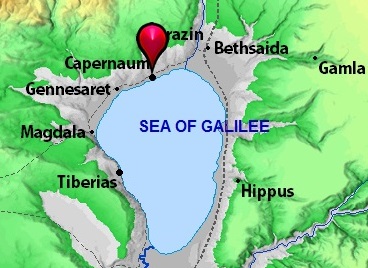|
|
By Joe Bartling
The Gospel of John is known as the “Christological” Gospel; its purpose to explain that Jesus is the “divine Son of God” and generally believed to have been written between 90-110 CE, about 60-80 years after Jesus was crucified in Jerusalem.
But perhaps the Gospel of John can give us some clues as to some of the physical and geographical locations of some activities and shed some light on what was going on in the Northern Galilee when Jesus arrived “on the scene”.
John 1:19 says that “Jews sent out priests and Pharisees, to ask him [John] who he is”. Those sent out were identified as Pharisees in John 1:24. When they ask him, John quotes Isaiah 40:3:
“I am ‘The voice of one crying in the wilderness: “Make straight the way of the LORD,” ’ as the prophet Isaiah said.” John 1:23
John 1:28 gives us the location:
“These things were done in Bethabara beyond the Jordan, where John was baptizing.”
Two other versions of the original writings, NUText and MText versions replace the word Bethabara (G962 – “house of the ford”) found in the Textus Receptus source, with the word “Bethany”. In any event, this gives us a perspective that John was baptizing “beyond” the Jordan River, and perhaps at a “ford”. A “ford” is a place where “crossing a river or stream” is made possible by wading, and is a natural phenomenon, as opposed to a deep water channel.
In John 1:29, John (the Baptist) sees Jesus coming to him, and proceeds to baptize him at this location, beyond the Jordan, and perhaps at this “ford” in the river.
The next day, in other words. NEARBY where John baptizes, John is talking with two of his disciples, according to John 1:35, and sees Jesus, and tells the two disciples, one of whom we find out in John 1:40, is Andrew, “Simon Peter’s brother”,
“And looking at Jesus as He walked, he said, “Behold the Lamb of God!” John 1:36
We are told in John 1:37, that John’s two disciples, who have heard Jesus speak, follow Jesus. One of these disciples, Andrew, searches out his brother Simon, tells him that he has found the messiah, and brings him to meet Jesus. The next day, in “the Galilee” according to John 1:43, Jesus finds Philip, who is from Bethsaida, and the next verse tells us that all three men, Andrew, Simon, and Philip, are from Bethsaida.
“Now Philip was from Bethsaida, the city of Andrew and [Simon] Peter.” John 1:44
So, at this point, Jesus has four disciples, the two disciples of John the Baptist, one of whom is Andrew, Simon Peter’s brother, Philip, and Simon Peter, and at least three of the four of them are from Bethsaida. At this point, we still don’t know who Jesus’ fourth disciple is, or where he is from.
I’m concluding from this information that the location where John the Baptist is baptizing is at the Jordan River, near Bethsaida, and perhaps near a ford up the river where the Jordan River enters the Sea of Galilee, 5 miles from Gamla. Next we learn that Philip finds Nathaniel:
“Philip found Nathanael and said to him, “We have found Him of whom Moses in the law, and also the prophets, wrote—Jesus of Nazareth, the son of Joseph.” John 1:45
Now this is interesting. Philip is telling Nathaniel that they have found the one whom Moses spoke of in the Torah, likely referring to Moses’ statement in Deuteronomy 18:15
“The LORD your God will raise up for you a Prophet like me from your midst, from your brethren. Him you shall hear”
Philip tells Nathaniel that this one they have found is “Jesus of Nazareth, the son of Joseph”. As we discussed in my article, Is Jesus of Nazareth Really from “Nazareth”? What’s in a Word?, the term “Jesus of Nazareth” is probably a misinterpretation and mistranslation of “Yahshua HaNotzri”. We find out later in John 21:2 that Nathaniel is from “Kana” in Galilee, but more likely one of the kana’im (zealots) in Galilee, that found their home base at Gamla.
The term “son of Joseph” that Philip uses to describe Jesus is quite interesting. If Nathaniel didn’t know Jesus previously, it is also unlikely that he knew of a “Joseph” of whom Jesus descended. More likely, Philip is calling Jesus “ben Joseph”, and specifically Messiah ben Joseph, the messianic figure of the apocalyptic age who will descend from the tribe of Ephraim.
This means something to Nathaniel, who is a devout and faithful Jew, who Jesus recognizes as “one without guile” and was “under the fig tree”, a term used by the Hebrew prophets as the restoration of the Kingdom of Israel, the regathering of the twelve tribes, and the messianic age:
“But everyone shall sit under his vine and under his fig tree, And no one shall make them afraid;” Micah 4:4
“In that day, says the LORD of hosts, Everyone will invite his neighbor Under his vine and under his fig tree.” Zechariah 3:10
In John 1:51, Jesus tells Nathaniel that “Most assuredly, I say to you, hereafter you shall see heaven open, and the angels of God ascending and descending upon the Son of Man.”, referring to the patriarch “Jacob’s Ladder” vision at Bethel in Genesis 28:12.
So now Jesus has 5 disciples, at least 3 (and maybe 4) are from Bethsaida, and Nathaniel, who is from the Galilee, near Bethsaida, from a place called “Cana”.
Now, lets look at the next verse, its the next (now the third) day, and there is a wedding “at Cana” in Galilee, again clearly near this site of the baptizing, the Jordan River, and Bethsaida. Jesus was called there, with his disciples, that now number five.
The text says that Jesus’ mother tells him, “they have no wine”. Perhaps she was referring to Jesus’ five disciples when she said “they have no wine”. This brings up an interesting question. Why was there no wine at the wedding? The text does not indicate that they “ran out of wine”. It says “they have no wine”. And the stone pots used for Jewish purification had water in them, not wine. Could it be that this was a ritualistic Jewish wedding of zealous believers, of whom many did not drink wine, perhaps because of Nazarite vows or other purity restrictions? This was Jewish Galilee, and a few of these towns in the first century CE had taken ritual purity laws seriously, as covered in my article, The Case of the Missing Red-Slipped Dishes in Gamla.
The five disciples who came to the wedding were not from the community, so perhaps Jesus’ mother wanted to offer them wine in order to be hospitable, in the tradition of Abraham and Sarah?
We assume that Jesus’ brothers are at the wedding, because in John 2:12 it says this:
“After this He went down to Capernaum, He, His mother, His brothers, and His disciples; and they did not stay there many days.”
Note the language, “went down to Capernaum”. This is the exact same language used in Luke 4:31, when Jesus’ fellow townspeople wanted to throw him headlong off the precipice on which their town was built. We have already suggested that this town is Gamla, Jesus’ Boyhood Hometown: Rediscovered after 2,000 Years?, just a 3-hour walk from Capernaum, and 60 minute walk from Bethsaida.
The first two chapters of the Gospel of John are telling us quite a bit about the Northern Galilee area, where the Jordan River bisects the shore between Capernaum and the “other side”, where Bethsaida and Gamla are, a short walk away. The Wedding “of Kana’im” was likely in the nearby vicinity too, not 30 miles away where “tradition” places a town called “Cana”.



Leave a comment
You must be logged in to post a comment.